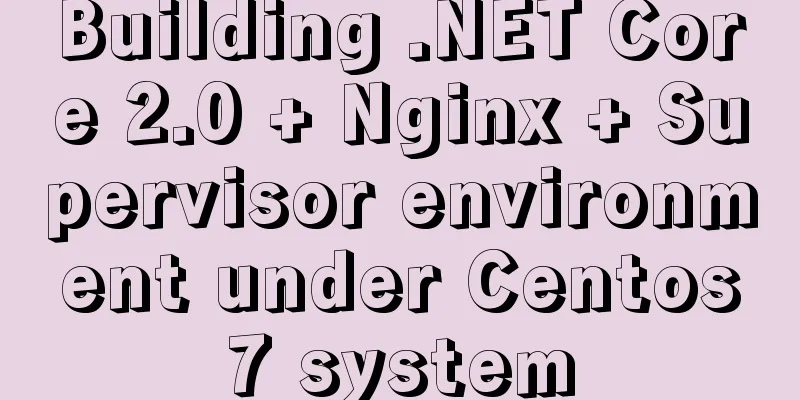Building .NET Core 2.0 + Nginx + Supervisor environment under Centos7 system

|
1. Introduction to Linux .NET Core Microsoft has always provided .NET support only for its own platform, which means that support for this "theoretically" cross-platform framework on Linux and macOS can only be provided by third-party projects (such as Mono .NET). Until Microsoft launched the fully open source .NET Core. This open source platform is compatible with .NET Standard and provides a completely consistent API on Windows, Linux, and MacOS. Although this small .NET framework is only a subset of the standard .NET, it is already quite powerful. On the one hand, this small framework allows some functional applications to run on three platforms at the same time (just like some functional Python scripts). On the other hand, it also allows server operators to deploy ASP.NET service programs on Linux servers (especially for servers that have difficulty running Windows Server). Official website reference: https://www.microsoft.com/net/core#linuxcentos 2. Preparation before deploying Linux .NET Core 2.0 environment 1. Environmental description: Server system: CentOS 7.2.1511 2. Preparation before installation (turn off firewall, turn off selinux) 1) Turn off the firewall: systemctl stop firewalld.service #Stop firewall systemctl disable firewalld.service #Disable firewall startup firewall-cmd --state #View the default firewall status (notrunning is displayed when closed, and running is displayed when opened) 2) Turn off selinux sed -i "s/SELINUX=enforcing/SELINUX=disabled/g" /etc/selinux/config Check the modified file as follows: [root@localhost ~]# cat /etc/selinux/config # This file controls the state of SELinux on the system. # SELINUX= can take one of these three values: # enforcing - SELinux security policy is enforced. # permissive - SELinux prints warnings instead of enforcing. # disabled - No SELinux policy is loaded. SELINUX=disabled # SELINUXTYPE= can take one of three two values: # targeted - Targeted processes are protected, # minimum - Modification of targeted policy. Only selected processes are protected. # mls - Multi Level Security protection. SELINUXTYPE=targeted 3) Restart CentOS reboot 3. Centos deploys .NET Core 2.0 environment 1. Add DOTNET products Before installing .NET Core, you need to register with Microsoft Product Feeds. This only needs to be done once. First, register your Microsoft signing key, then add your Microsoft product feed. rpm --import https://packages.microsoft.com/keys/microsoft.asc sh -c 'echo -e "[packages-microsoft-com-prod]nname=packages-microsoft-com-prod nbaseurl=https://packages.microsoft.com/yumrepos/microsoft-rhel7.3-prodnenabled=1ngpgcheck=1ngpgkey=https://packages.microsoft.com/keys/microsoft.asc" > /etc/yum.repos.d/dotnetdev.repo' 2. Install .NET Core SDK Before you proceed, remove any previous preview versions of .NET from your system. The following commands update the list of products for installation, install the components required for .NET Core, and then install the .NET Core SDK. yum update yum install libunwind libicu -y yum install dotnet-sdk-2.0.0 -y 3. Check whether dotnet is installed successfully and check the version dotnet --info dotnet --version 4. Test .NET Core 2.0 environment 1. Initialize a test environment in the home directory and output "Hello World" content (test method 1, can be ignored) cd /home dotnet new console -o hwapp cd hwapp dotnet run The output is empty as follows: [root@localhost hwapp]# dotnet run Hello World! 2. Upload the .net core instance page for testing (test method 2, recommended) Centos .net core 2 environment test case (upload it to the /home directory or a custom directory) Download address: http://down.51cto.com/data/2334968 Execute the following command cd /home/WebApplication1 dotnet restore //If you have used test method 1, you need to execute this command to reload the current new website file dotnet run After running, the following figure is shown:
Access the test page through IE
5. Install and configure nginx to forward ASP.NET Core applications 1. Install Nginx environment [root@localhost ~]#curl -o nginx.rpm http://nginx.org/packages/centos/7/noarch/RPMS/nginx-release-centos-7-0.el7.ngx.noarch.rpm [root@localhost ~]#rpm -ivh nginx.rpm [root@localhost ~]#yum install nginx -y Type: systemctl start nginx to start nginx. [root@localhost ~]# systemctl start nginx Enter: systemctl enable nginx to set nginx to start up (Linux will automatically run nginx when it crashes or restarts, so you don't need to connect to it to enter commands) [root@localhost ~]#systemctl enable nginx Created symlink from /etc/systemd/system/multi-user.target.wants/nginx.service to /usr/lib/systemd/system/nginx.service. 2. Check whether you can access it through IE [root@localhost nginx-1.8.1]# ps -ef|grep nginx root 14626 1 0 08:47 ? 00:00:00 nginx: master process nginx nginx 14627 14626 0 08:47 ? 00:00:00 nginx: worker process root 14636 3269 0 08:49 pts/1 00:00:00 grep --color=auto nginx
Commonly used operation commands of nginx systemctl start nginx.service #Start nginx service systemctl enable nginx.service #Set up automatic startup systemctl disable nginx.service #Stop booting and starting automatically systemctl status nginx.service #View the current status of the service systemctl restart nginx.service #Restart the service systemctl list-units –type=service #View all started services 4. Firewall configuration (if the system has a firewall, you need to write rules) Command: firewall-cmd –zone=public –add-port=80/tcp –permanent (open port 80) Command: systemctl restart firewalld (restart the firewall to make the configuration take effect immediately) 5. Configure nginx to forward ASP.NET Core applications Modify the /etc/nginx/conf.d/default.conf file. Replace the file contents with
server {
listen 80;
location / {
proxy_pass http://localhost:88;
proxy_http_version 1.1;
proxy_set_header Upgrade $http_upgrade;
proxy_set_header Connection keep-alive;
proxy_set_header Host $host;
proxy_cache_bypass $http_upgrade;
}
}Reload nignx [root@localhost nginx]# nginx -s reload The configuration of nginx has been completed 6. Open dotnet run for testing [root@localhost ~]# cd /home/WebApplication1/ [root@localhost WebApplication1]# dotnet run Using launch settings from /home/WebApplication1/Properties/launchSettings.json... Hosting environment: Development Content root path: /home/WebApplication1 Now listening on: http://[::]:88 Application started. Press Ctrl+C to shut down. Access via IP port 80
6. Configure Supervisor There are three problems Question 1: The ASP.NET Core application runs in the shell. If you close the shell, you will find that the ASP.NET Core application is closed, making the application inaccessible. This is certainly not a situation we want to encounter, and the production environment has zero tolerance for this situation. Question 2: If the ASP.NET Core process terminates unexpectedly, you need to manually connect to the shell to restart it, but this operation is often not timely enough. Question 3: If the server goes down or needs to be restarted, we still need to connect to the shell to start it. To solve this problem, we need a program to monitor the status of the ASP.NET Core application. Restart the application immediately if it stops running. Here we use the Supervisor tool, which is developed using Python. 1. Install Supervisor [root@localhost /]# yum install python-setuptools -y [root@localhost /]#easy_install supervisor 2. Configure Supervisor [root@localhost /]#mkdir /etc/supervisor [root@localhost /]#echo_supervisord_conf > /etc/supervisor/supervisord.conf Modify the supervisord.conf file and change the configuration at the end of the file [root@localhost /]# vi /etc/supervisor/supervisord.conf Change the last two lines: ;[include] ;files = relative/directory/*.ini Change to [include] files = conf.d/*.conf ps: If the service has been started, you can use the "supervisorctl reload" command to modify the configuration file to make it effective 3. Configure the ASP.NET Core application guard Create a WebApplication1.conf file with the following content: [root@localhost /]# vi WebApplication1.conf [program:WebApplication1] command=dotnet WebApplication1.dll ; Command to run the programdirectory=/home/WebApplication1/ ; Directory where the command is executedautorestart=true ; Whether to automatically restart the program if it exits unexpectedlystderr_logfile=/var/log/WebApplication1.err.log ; Error log filestdout_logfile=/var/log/WebApplication1.out.log ; Output log fileenvironment=ASPNETCORE_ENVIRONMENT=Production ; Process environment variableuser=root ; User identity of process executionstopsignal=INT Copy the file to: "/etc/supervisor/conf.d/WebApplication1.conf" [root@localhost /]#mkdir /etc/supervisor/conf.d [root@localhost /]#cp WebApplication1.conf /etc/supervisor/conf.d/ Run supervisord to see if it works [root@localhost /]#supervisord -c /etc/supervisor/supervisord.confsupervisord -c /etc/supervisor/supervisord.conf [root@localhost /]# ps -ef | grep WebApplication1 root 29878 29685 0 09:57 ? 00:00:00 dotnet WebApplication1.dll root 29892 29363 0 09:57 pts/3 00:00:00 grep --color=auto WebApplication1 If the dotnet WebApplication1.dll process exists, it means that the operation is successful. At this time, you can access it using a browser.
At this point, the configuration of the ASP.NET Core application guard is complete. Supervisor daemon common operations Start supervisord Stop supervisord [Reload configuration file] 7. Configure Supervisor startup Create a new "supervisord.service" file [root@localhost /]# vi supervisord.service # dservice for systemd (CentOS 7.0+) # by ET-CS (https://github.com/ET-CS) [Unit] Description=Supervisor daemon [Service] Type=forking ExecStart=/usr/bin/supervisord -c /etc/supervisor/supervisord.conf ExecStop=/usr/bin/supervisorctl shutdown ExecReload=/usr/bin/supervisorctl reload KillMode=process Restart=on-failure RestartSec=42s [Install] WantedBy=multi-user.target Copy the file to: "/usr/lib/systemd/system/supervisord.service" [root@localhost /]# cp supervisord.service /usr/lib/systemd/system/ Execute command: systemctl enable supervisord [root@localhost /]# systemctl enable supervisord Created symlink from /etc/systemd/system/multi-user.target.wants/supervisord.service to /usr/lib/systemd/system/supervisord.service. Execute the command: systemctl is-enabled supervisord #to verify whether it is started at boot time [root@localhost /]# systemctl is-enabled supervisord Restart the system to see if you can access it successfully [root@localhost /]# reboot
The above is the detailed method of building .NET Core2.0+Nginx+Supervisor+Mysql environment under Centos7 system. I hope it will be helpful to everyone. You may also be interested in:
|
Recommend
Introducing multiple custom fonts in CSS3
Today I found a problem in HTML. There are many d...
HTML table tag tutorial (46): table footer tag
The <tfoot> tag is used to define the style...
How to create, save, and load Docker images
There are three ways to create an image: creating...
How to restore single table data using MySQL full database backup data
Preface When backing up the database, a full data...
Hide HTML elements through display or visibility
Sometimes we need to control whether HTML elements...
Introduction to MySQL method of deleting table data with foreign key constraints
When deleting a table or a piece of data in MySQL...
Methods and steps to use http-proxy-middleware to implement proxy cross-domain in Node
Table of contents 1. Install the proxy module 2. ...
Font Treasure House 50 exquisite free English font resources Part 1
Designers have their own font library, which allo...
Detailed tutorial on deploying Hadoop cluster using Docker
Recently, I want to build a hadoop test cluster i...
Application examples of WeChat applet virtual list
Table of contents Preface What is a virtual list?...
mysqldump parameters you may not know
In the previous article, it was mentioned that th...
SMS verification code login function based on antd pro (process analysis)
Table of contents summary Overall process front e...
js to realize a simple advertising window
This article shares the specific code of js to im...
Detailed explanation of MySQL database isolation level and MVCC
Table of contents 1. Isolation Level READ UNCOMMI...
Vue3 Vue Event Handling Guide
Table of contents 1. Basic event handling 2. Send...












